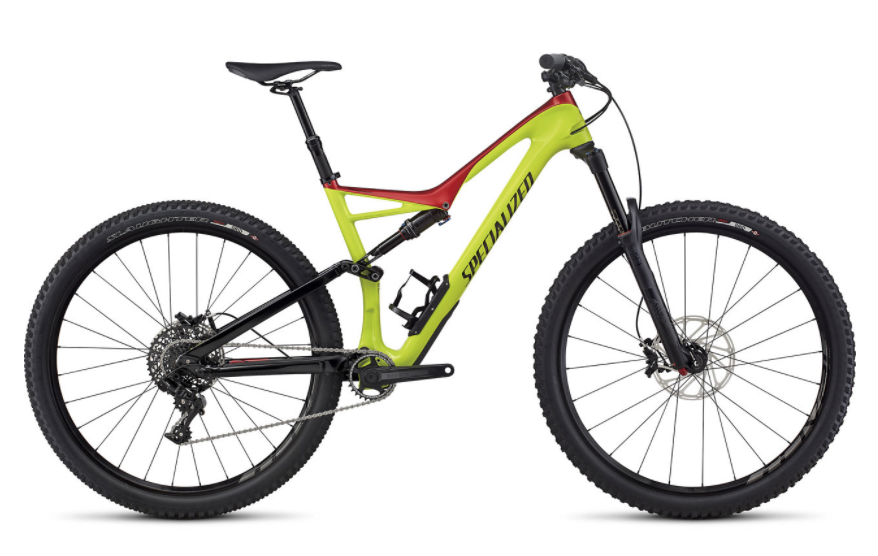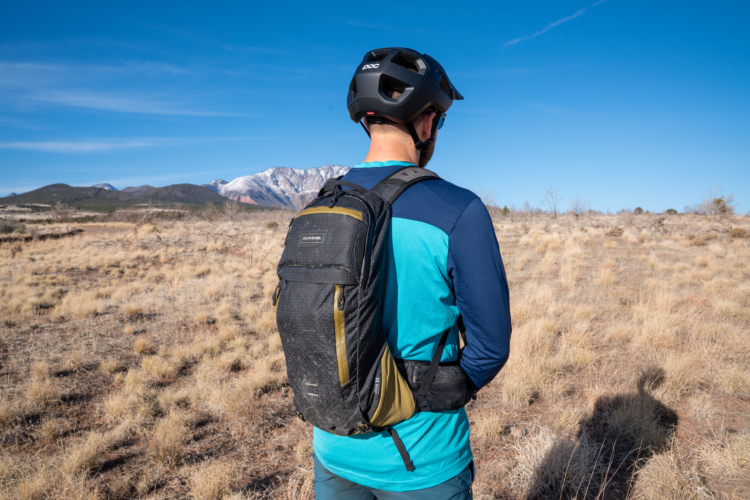
YT Industries is one of the brands giving online, direct-to-consumer mountain bike sales a good name. With the availability of high-quality mountain bikes from companies like YT that are visually unique with a reputation for great performance, no longer are internet-only brands simply offering off-the-shelf bike frames from China.
Their race team, dubbed the “YT Mob,” backs up their products, too. YT lured the fastest downhill racer in the world, Aaron Gwin, to their brand in early 2016. Last season, Gwin took the 1st place overall Downhill World Cup title aboard YT’s Tues DH rig. In addition to Gwin, Angel Suarez races for the Mob, and riders Andreu Lacondeguy, Cameron Zink, Bryan Regnier, and Yannick Granieri are also a part of the YT Family, riding, filming, and competing on YT bikes. The late Kelly McGarry is also a member of the YT Family, from 2015 and in perpetuity (RIP).
So YT has the racer chops, it has the looks (see below), it has the price (see far below), but how do their bikes actually ride? This was a question I pondered for years, and I finally had a chance to answer it for myself.
Jeffsy CF One 29

I recently tested the YT Jeffsy CF One 29 in California. Technically, I believe I was on the 2016 model, but the changes in 2017 for the 29″ model are minimal. The big change for the Jeffsy line in 2017 is the addition of a 27.5″ model, which I haven’t had a chance to ride (yet).

The Jeffsy is a 140mm-travel 29er that YT labels “All Mountain.” Some in the US might call this a “Trail” bike, but at this point we’re arguing semantics. The “CF” in the model name denotes that this is the carbon fiber version of the Jeffsy frame. The tubing features increased thickness in critical areas for enhanced durability. While I’ll dive into the geometry below, you’ll see multiple numbers quoted for certain measurements–this is due to flip chip technology in the rear suspension linkage. While by no means a technological innovation unique to YT, flipping the chip in the Jeffsy’s linkage changes the ride characteristics of the bike significantly, allowing you to essentially own two different mountain bikes in one frame. I rode the Jeffsy in the lower, more aggressive configuration.
The size medium Jeffsy I rode features a 66.9/67.6° head tube angle,74.7/75.3° seat tube angle, and a 32/24mm bottom bracket drop. Chainstays measure 435mm, top tube length is 592mm, reach is 425mm, seat tube length is 440mm, and stack is 610mm. The total wheel base measures 1,154mm long. For full geometry specs, be sure to check the chart on YT’s website.
Build Kit and Pricing

The One 29 model I tested comes built up with a RockShox Monarch RT3 rear shock and a Pike RCT3 fork; SRAM X1 1×11 drivetrain and Guide RS brakes; E*thirteen TRS 29″ wheels; and a Race Face Turbine cockpit including bars, stem, cranks, and dropper post. Total claimed weight is 28.2lbs.
The One 29 model retails for $3,999, but the Jeffsy 29er is available in a plethora of build levels. The carbon fiber models run as high as $5,599, and the aluminum models run as low as $2,599.

Lower cost is generally touted as the primary reason to purchase from a direct-to-consumer company like YT, so I found two similar models from other brands to compare the Jeffsy to. The first is the Specialized Stumpjumper FSR Comp Carbon 29, which retails for $4,000 and offers 135mm of rear wheel travel. While the Stumpjumper offers a similar amount of travel, the frame only features carbon on the front triangle. It substitutes aluminum for the rear triangle. Also, all of the components are one (or more) steps below those found on the Jeffsy One 29. This model of the Stumpy features a RockShox Yari fork and Monarch RT shock, SRAM GX 1×11 drivetrain, and SRAM Guide R brakes.

The Trek Fuel EX 9.7 29 retails for $3,999 and is very similar to the Specialized above. While it has 130mm of travel VS the 140mm found on the Jeffsy, it’s the closest offering in Trek’s line. The frame of the EX 9.7 is carbon up front with aluminum stays in the rear, like the Stumpjumper. The parts kit features a Fox Rhythm 34 fork, Fox Performance EVOL shock, a Shimano GX 1×11 drivetrain, and a KS eThirty Integra dropper post. The brakes are Shimano Deore, arguably even a step below those found on the Specialized (not to mention the YT).
Dollar for dollar, YT does offer a better value proposition than two of the biggest mountain bike brands. Yet while the difference is noticeable, it’s not exactly astronomical.
But the real question is: “how does the Jeffsy Ride?”
Out on the Trail

While I only had the chance to conduct what I call a “test ride review” over the course of just one day, I was able to pedal the Jeffsy almost 20 miles across several different trails and types of terrain in Santa Barbara, California. Here’s what I found.
The Jeffsy was a true delight to pedal up the climbs, especially considering the 140mm of suspension travel. At 28.2lbs complete, this is a very reasonable weight for a 140mm-travel 29er, making the climbs drop away rapidly into the background. While the pedaling platform was confidence inspiring even with the suspension full-open, I did appreciate having both pedal and climb (fully locked out) modes for both the rear shock and the fork. Especially at this relatively reasonable price point, finding capable compression adjustment was a treat.

The beauty of the Jeffsy is how it combines confidence-inspiring descending prowess with those excellent climbing legs. When we dropped into the Romero Canyon trail the first time, I wasn’t sure what to expect from the singletrack in front of me. The trail provided a mixed bag from fast and flowing, to switchbacked corners, and finally a truly gnarly lower section with rock hucks, lips to catch air off of, bouldery rock gardens filled with dangerous-looking square-edged hits, and technical creek crossings with out-of-the-saddle grunts to get out of the drainages.
Romero Canyon was a brutal test track that absolutely punished the Jeffsy, forcing me to push it to its limits. In many places, I found myself wishing for my personal 160mm-travel enduro rig instead of a 140mm trail bike. And yet, while the Jeffsy bucked harder than my personal rig as its rims pinged off the square-edged hits, it brought me out the other side in one piece, stayed on line, and positively flew through the gnar when I forced myself to ease off the stoppers.
After my second lap on Romero Canyon, I found myself incredibly impressed by how capable this 140-mil bike proved to be. In fact, I could have probably pushed harder and faster, caught more air, and generally gotten rowdier if I had a bit more experience with this rig. While at first I felt as if I was pushing the Jeffsy all the way to its limits, after two runs on the same trail I realized that the Jeffsy still had more to give.

Much of this long-legged feeling is due to the progressiveness of the Jeffsy’s travel. While I pushed the O-rings close to the limit on both the fork and the shock, I never blew the O-ring completely off the shock and I never felt a harsh bottom out in either suspension component, even on square-edged hits. I did feel the rear wheel hang up and catch hard on a few square-edged rocks, but I chalk that up to an undergunned rear tire that deflected poorly and led to several rim hits, not the suspension.
In fact, while chatting with Cam Zink about the Jeffsy, he said that both the Jeffsy and the Capra offer two of the most progressive suspension designs on the market today. The YT website also claims that the Jeffsy’s suspension is “progressive, with lots of mid-travel support.” After riding this bike myself, I can confirm this claim of radical progressiveness. Even after hucking my meat blind into a boulder-filled landing, that mid-travel support and ramp up at the end of the suspension stroke really saved my bacon, allowing me to easily come back to earth and ride out of the rocky landing without skipping a beat.
Final Thoughts
The Jeffsy is a superbly well-rounded mountain bike. Not only does it scale the mountainside with ease, but the progressiveness of the suspension and the reliability of the proven components allow it to descend more confidently than the specs might have you believe. While sure, a bike with more suspension, like the Capra, will offer more forgiveness and burliness, if you come to an obstacle that you “can’t ride” while aboard the Jeffsy, don’t blame the bike!





















1 Comments
Mar 30, 2017